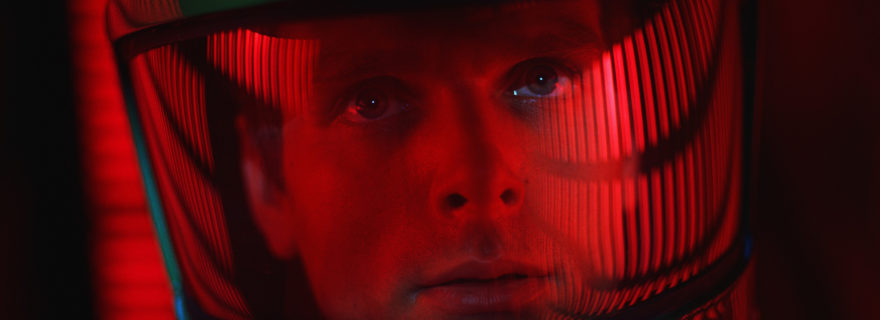'2001: A Space Odyssey'
Movie Rating:
5
What can be said about one of the most wondrous films ever made? How about that one hated it the first time he saw it? Screened on VHS on a 20″ Trinitron, the only thing I knew about ‘2001: A Space Odyssey’ was that the people behind ‘Star Wars’ were obsessed with it.
I’d learn later that the likes of Stuart Freeborn (Yoda creature builder), Colin Cantwell (original model/concept designer prior to McQuarrie) and Douglas Trumbull (photographic effects), as well as numerous other production and technical personnel, connected these works on fundamental levels. Still, the differences in scope and ambition on both films remains different, and my young brain couldn’t understand why the hell there were so many monkeys in the damn thing.
I’ve seen the film dozens of times since (including a screening timed to New Years, with the intermission hitting at 11:55pm on December 31, 2000), and many times on the 70mm print that was assembled in the 1990s. For the 50th anniversary, Warner Bros. is treating audiences to a so-called “unrestored” version that promises to bring audiences closer to the 1968 release. Thanks to the star power of Christopher Nolan, who paved the way with his ‘Dunkirk’ rollout, a circuit of 70mm projectors is ready to accommodate.
The premiere of this project took place at the luminous Debussy Theatre in Cannes, complete with black tie red carpet and plenty of hoopla. It’s a worthy celebration of the film (Kubrick was shunned by the festival), and the theater was packed with viewers eager for such an occasion.
For the more technically minded, however, the experience was both wonderful and frustrating. Nolan has a tendency to be evangelical about analog presentations, eschewing technical arguments in favor of notions of “emotion.” He has talked at length about how this is to be the closest to the original presentation as possible.
Of course, that’s not exactly the case. The print was struck, by Nolan’s own admission, from a negative made from a 1990s era interpositive. This then gets printed to an internegative, and that’s used to print (on contemporary stock) the new theatrical release. The print I saw had inherent flaws beyond the usual dust and blips, including a noticeable vertical scratch through some scenes. Audio dropouts occurred during reel changes, and the color density changed constantly, particularly during the front projection sequences in the Dawn of Man section.
Other sequences, particularly those in space, were sublime. Black levels were blissfully dark, with pinprick stars and the texture of the pod, ships or moonscape rendered stunningly. Above all, it embodied the scope of Kubrick’s work, meant as always to be seen on the biggest screen possible. From front row center at one of the world’s great cinemas, it was an unforgettable delight.
The sound in the room was particularly impressive, with the 6-track audio providing full spectrum immersion. The silences were something to behold. The anticipation of the audience watching in rapt attention as the coldness of space prevented any noise, only to have the whoosh and hum of the station return suddenly. ‘2001’ could still be considered a masterpiece even if you closed your eyes and simply listened to the whole thing, such is its craft.
I confirmed with Warner executives that the 4k HDR version assembled from scans of the original camera negative will come to retailer shelves this fall, and there will not be a theatrical run for that presentation. This is unfortunate; a newly struck print from these new scans could, if treated well, provide an even more representative version of the original presentation. The state of film archiving is always in flux, of course, but a newly struck 70mm print from this digital master would likely serve even more supremely the vision that Kubrick and his collaborators had (though, I’ll go on a limb, he’d be absolutely aghast at the decision to screen a compromised print in favor of the latest in laser projection, given his unyielding perfectionism and fascination with technology).
It’s unfortunate that the waters are being muddied again about the supposed divide between analog and digital regarding the emotional connection to cinema. Take a look at Sony’s work on the 4k DCP for ‘Lawrence of Arabia’ to see how such masterpieces can be treated with the utmost respect for the source while ensuring the immortality of their images.
Still, if this release gets the film out to more viewers who have only seen ‘2001’ at home, it’s already a success. This is a journey that should be taken by any cinephile as many times as possible. While one can certainly wish for a more technically literate audience unswayed by Nolan’s “unrestored” arguments that in some ways diminish the digital work that’s to be released, we can all agree that this is a motion picture well worth getting off the couch for, a marvel of moviemaking best experienced in the biggest cinema you can find near you.
This review is filed from the Cannes Film Festival, where Christopher Nolan premiered the new “unrestored” 70mm print of ‘2001: A Space Odyssey’. This version of the film will receive an American theatrical re-release starting May 18th, 2018 in selected theaters.






genesim
You know what seems to be lost in all this mish mosh of negative vs printing….that the director would often have input on what kind of effects are printed later. The negative is often not what the director wanted, and anytime a digital scan is incorporated you often have people that are outside of the original artist intent.
Take Mr. Harris. He insists that the negative is the only way to go, yet Kubrick I am sure without question supervised the first release print and there is evidence on his notes how he wanted it to look outside the original negative.
It is like comparing a printed picture vs a negative. While a negative has the capacity to be closer to the source when the camera was clicked, it does not and will not have the exact parameters of the photograph you physically fell in love with. The photo in this case is what your remember. While people like you will claim that the digital scan of the negative is more accurate, what you fail to factor in is that in the digital world you will always always always have a change in what was printed initially. A scan of the negative can only accurately render a negative, not the release print which is what the public saw and fell in love with.
It is like comparing a master tape to a record. Sure a digital capture of the master tape gives all this so called accuracy (and I call it frequencies that are outside of the comfortable limited listening range), but what if the listener wants what they grew up listening to? Recreating the sound of the vinyl is not so easy, and any fool that thinks they can digitally needs to get back to basics. The same is true of a release print. No wonder there is raging debate. It is like people have decided what others should value. I have not told you what you should value…but by golly it sure isn’t the other way around!
Of course Josh you will jump all over me and say I am contradicting myself. NO I AM NOT. I am stating what I know to be true. In my world, both would be scanned, and better care would be given to match what the public saw vs some “expert” deciding that the release prints are trash and not to be considered at all…much less the artists notes which I know for a fact with all the crappy “restorations” were not even in the equation.
Josh Zyber
Those are some wonderful rationalizations you’ve created to justify preferring an inferior copy. Enjoy all those scratches and dirt and color problems. Truly.
genesim
“inferior” is you opinion, and I respect you having your opinion even if you place little to no value on the analog print which is what the public saw and fell in love with.
Yeah I will enjoy the scratches because even if with worn images at least that is REAL as opposed to the digital wash over that just creates another vision outside of the original artist.
It is not like Nolan wants there to be only analog printing. He obviously still supports digital restoration.
To some of us that want to see a save state and to get an idea of what was originally shown, what is wrong with that? I recently was salivating over the prospect of seeing Valley Girl in an original 35 mm print showing. Why anyone that loves the film would pass up that opportunity I will never know. I recently purchased Savannah Smiles. The original negative was not accessed at this time for the bluray. Guess what, a decent scan of that print will produce similar results to what I saw in the theater, and again, what is wrong with that? I would not be fool enough to believe that it is exactly what I saw, but I don’t happen to have a projector laying around showing the 35 mm print either. BUT if it was economical and playing near me, do you think I for a moment would be fool enough to think that even a 4K scan was going to be better than an analog film showing the real frickin’ deal (barring if the print was in good shape or not)???
I mean going back to Nolan, he actually went in and restored his own movies to 4K bluray did he not? It is like to SOME people he tried to burn all digital process factories? We all know that after a 70 mm printing that there will be a digital restoration of some kind? Matter of fact, in 2001’s case, the digital 4K restoration was/is already taking place??? People like Mr. Harris and Ned Price get to see the WIP before they put their digital trickery to use, why can’t anyone else? Why is their vision the only vision worthwhile??
What about the fact that 70 mm presentations are actually preserving huge screen movie houses? What about the fact that when one day we go to 8K+ projection that there just may be decent movie theaters to go to (but not if some people keep crapping all over Nolan for “fetish” or Abrams for “retro”)? What about the preservation of seeing film projected better to begin with (digital or analog)? What about keeping people going out as opposed to Harris who in his own words to me said that any analog CURRENT print of any film should not be allowed to exist! What kind of government censorship like talk is that? Who made him in charge of what people decide to manufacture and project?
Mr. Harris is aware that Imax is still big bucks and yet he wants to decry that all translations should be 4K only and just as beautiful? SAY WHAT? Isn’t Imax 15/70 been reported to be at least 12K resolution equivalent? Even if if Mr. Harris thinks that “4K” (because again, after filters, it is not) projection is just fine, what about the rest of the world that understands what they actually see? You stated that 8K scanned to 4K downsampled projected is better than Imax analog projected….whatever you say. I am not buying that for even a fleeting second and I haven’t have seen 8K scanned material because I have been to digital Imax a crap ton of times! Matter of fact, it is a shame that photochemical Imax is going away while crap quality lower scans are taking forefront.
At least Hateful Eight or Dark Knight were negative cut (accept for the special effects shots).
By the way Josh, amidst all this, you know what I feel like doing…I want to see more 70 mm films..like now.
I have Lawrence of Arabia, Sound of Music, West Side Story, Mad Mad World, Ben Hur, The Master, Hateful Eight, Nolan’s work, Imax, Transformers movies… lets put this to something positive since you pretty much don’t value anything that I say or any point that I have made (not trying to be hostile, just telling you the truth, and please don’t go on about this idea that I changed my view)….
What is a personal 70 mm bluray favorite film of yours? I was recently gave a credit for a misdirected package and was hankering for a good looking 70 mm film. Any suggestions? You obviously review a lot of film and perhaps have seen quite a bit more than me, I have thousands of films, but I am sure you do, or had access to more.
So care to give me your opinion? Lets let all this rest. We will never agree. But I wouldn’t mind learning this from you. I one time sold Battle of the Bulge and regret that. I was thinking that may be a good one to re-own because it is at least not as processed?
What I am basically looking for is this in this order:
1st A great viewing experience (if it is better than even being a good movie)
2nd A great viewing experience, but also a good movie.
3rd A great viewing but a so so movie
The one film that I wish was transferred properly. T2 3D: Battle Across Time. Dual 70 mm would be just awesome. too bad there is no such thing as 4K-3D for consumers. A pity.
So in closing am I saying 4K sucks…no. But I am not saying it is 70 mm Imax print quality either!
Timcharger
2 pages of comments on this argument?!
Okay, I do know my answer now. I rather watch the Last Jedi and Hayden Christensen’s courtship scenes than this. And even watch them on a sandy beach. Despite sand getting everywhere!
Trond Michelsen
It seems to me that if you want to convince someone that film is objectively better than digital, and that it has nothing to do with subjective feelings, then the best way to proceed may not be to write hundreds of very long and extremely passionate posts about it,
genesim
Trond,
No wonder journals and peer reviewed evidence is not taken seriously anymore. Some people can’t even get past a Tweet length. Let us not trust instrumentation, lets just trust what this guy said or that guy said as “I like this and I don’t like that”.
Yeah, that isn’t subjective.
I mean I can see it now. I say that people detect more than with their eyes, so therefore I claimed that people see with hairs on their arms and I believe that eyes should be plucked out and not used at all!
Sorry, I tend to comment on people distorting my views to the point of obscenity.
Timecharger,
Annakin was a boy that lived as a slave on a barren land of sand pits. Give the poor kid a break, he hates sand! And yes it does get everywhere, much like the foolishness that analog prints should be excised from existence because they have no value.
Timcharger
Wow, gensim, wow! You connected Anakin’s hate for sand to your analog argument.
Okay, let’s go. Last Jedi’s unearned character conveniences, unrewarding plot continuity, and use of subversion only for the sake of subversion. Connect that all to your analog argument. And do it in a thousands words or more. Good luck!
genesim
Huh? I don’t see a connection only a comparison.
But go on with that Last Jedi hate. It seems to have made its way into completely different topics. What is next, do you drop down on Revlon lipstick discussions with Jar Jar impressions?
genesim
Josh,
In case you missed it I was trying to make peace asking for your advice. Surely you aren’t that mad at me. I was being serious.
Josh Zyber
I missed the question earlier. You already mentioned Lawrence of Arabia, which would be my first choice. Also Baraka and Samsara. (The IMAX film Chronos is from the same director as those two.)
The West Side Story Blu-ray is very problematic.
Unfortunately, many of the 65mm movies released on Blu-ray were mastered from 35mm reduction elements, including Branagh’s Hamlet and the original disc for 2001.
genesim
I admit fully I know nothing of Baraka, Samsara, or Chronos. It looks like a good place to start. Thank you and I will check them out. From what I read Samsara sound amazing!
While I went on about Harris, his work on Mad World was something to behold and was a gold standard for me. Lawrence is in another universe despite it not being my favorite film story wise (though after the third time through it is getting there).
To me, I am always trying to capture the greatness of Krzysztof Kieślowski, while I know he didn’t film 70 mm, the Three Color Trilogy and Decalogue had that mix of good stories and great look. I was fortunate enough to see the Trilogy in the movie theater and as good as the Criterion transfers are, there is without question something missing from what I saw (but that was a while ago, so my memory may be hazy).
Take care, we won’t be debating like this in the future, this one was a one off that I wanted to have out with you, for better or for worse and it was left over from a long time ago. Thanks for taking the time.
Gary Meyer
Is anybody interested in reviewing and comparing the 70mm “unrestored” to the 4K/ Imax release? I would consider running it in EatDrinkFilms.com in an upcoming Kubrick special issue.